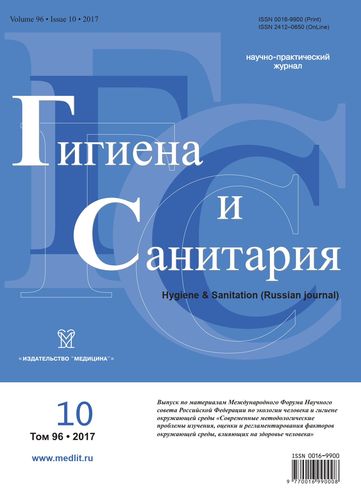Methodological and conceptual problems of oil pollution in soil
- Authors: Rusakov N.V.1, Vodyanova M.A.1, Starodubova N.Y.1, Donerian L.G.1
-
Affiliations:
- Center for Strategic Planning and Management of Medical and Biological Health Risks
- Issue: Vol 96, No 10 (2017)
- Pages: 929-933
- Section: PROBLEM-SOLVING ARTICLES
- Published: 21.10.2020
- URL: https://ruspoj.com/0016-9900/article/view/640696
- DOI: https://doi.org/10.47470/0016-9900-2017-96-10-929-933
- ID: 640696
Cite item
Full Text
Abstract
The relevance of the normalization of petroleum hydrocarbons in soil is due, inter alia, to their ubiquity. Negative impacts on soil cover, atmospheric air, surface and groundwaters, ecological systems and public health are noted at all stages of development of oil fields — from drilling to industrial processing, liquidation of equipment and delivery to the consumer. In addition, various technologies for the destruction of oil contamination (re-cultivation, sanitation, etc.) are actively being developed, but they are not widely used, because there is no norm for a safe level of their content for humans and environmental objects. The article deals with problems of hygienic regulation of petroleum hydrocarbons in the soil. Methods are presented for the quantitative determination of oil and oil products in soil, as well as conceptual issues in the system for estimating oil as a soil pollutant. The subordinate legislation, taking into account the lists of pollutants, in respect of which state regulation measures in the field of environmental protection are applied, are sanctified. Toxic oxygen-containing products are shown to be formed asa result of the transformation of the hydrocarbon component of the component composition of the oil. Threshold concentrations of the safe content of petroleum hydrocarbons in the soil in a vegetation experiment (500 mg/kg), water migration — 10,000 mg/kg and a total of 21,000 mg/kg were determined. Priority directions of research on the establishment of a safe level of oil hydrocarbon contamination in the soil according to the airborne migration index of harmfulness, as well as the quantitative determination of petroleum hydrocarbons in agricultural plants are indicated.
About the authors
Nikolay V. Rusakov
Center for Strategic Planning and Management of Medical and Biological Health Risks
Author for correspondence.
Email: rusakovnv39@yandex.ru
ORCID iD: 0000-0002-3754-009X
MD, PhD, DSci., professor, academician of RAS, the chief research scientist of Center for Strategic Planning and Management of Medical and Biological Health Risks, Moscow, 119991, Russian Federation.
e-mail: rusakovnv39@yandex.ru
Russian FederationM. A. Vodyanova
Center for Strategic Planning and Management of Medical and Biological Health Risks
Email: noemail@neicon.ru
ORCID iD: 0000-0003-3350-5753
Russian Federation
N. Yu. Starodubova
Center for Strategic Planning and Management of Medical and Biological Health Risks
Email: noemail@neicon.ru
ORCID iD: 0000-0002-5072-204X
Russian Federation
L. G. Donerian
Center for Strategic Planning and Management of Medical and Biological Health Risks
Email: noemail@neicon.ru
ORCID iD: 0000-0002-9718-0663
Russian Federation
References
- Rakhmanin Yu.A. Updating of the methodological problems of the regulation of chemical pollution of the environment. Gigiena i sanitariya. 2016; 95(8): 701–7. (in Russian)
- Abakumov E.V., Parnikoza I.Yu., Lupachev A.V., Lodygin E.D., Gabov D.N., Kunakh V.A. Content of polycyclic aromatic hydrocarbons in soils of Antarctic stations regions. Gigiena i sanitariya. 2015; 94(7): 20–5. (in Russian)
- Rusakov N.V., Rakhmanin Yu.A. Waste, Environment, Human [Otkhody, okruzhayushchaya sreda, chelovek]. Moscow: Meditsina, 2004. (in Russian)
- Konovalova E.V., Korsunova T.M. Application of ameliorants in oil-contaminated soils: agricultural and environmental aspects. Agronomiya. 2015; (3): 16–21. (in Russian)
- Ignat’ev Yu.A., Zaynulgabidinov E.R., Petrov A.M., Khabibullin R.E. Dynamics of the content of organic matter in oil-contaminated soil in the presence of a humic preparation and the preparation «Melaphene». Vestnik tekhnologicheskogo universiteta. 2016; 19(6): 149–51. (in Russian)
- Uzkikh O.S., Khomyakov D.M., Doner’yan L.G. Sensitivity of Parameters of Biological Monitoring of Various Oily Soils. Ekologiya i promyshlennost’ Rossii. 2009; (5): 18. (in Russian)
- Vodyanova M.A. Biotesting and microbiological methods in assessing soil contamination. Gornyy informatsionno-analiticheskiy byulleten’ (nauchno-tekhnicheskiy zhurnal). 2006; (8): 202–6. (in Russian)
- Tarasova Zh.E. Hygienic assessment of the oil influence on the soil microbiota and self-cleaning capacity of the soil: Diss. Moscow; 2006. (in Russian)
- Khusnutdinova N.Yu., Dubinina O.N. Translocation of petroleum hydrocarbons into agricultural plants. Meditsina truda i ekologiya cheloveka. 2016; (3): 65–8. (in Russian)
- Siron R., Pelletier E., Brochu C. Environmental factors influencing the biodegradation of petroleum hydrocarbons in soil. Arch. Environ. Contam. Toxicol. 1995; 28(4): 406–16.
- Krasovitskaya M.L. Questions of Air Hygiene in Areas of Oil Refining and Petrochemical Industries [Voprosy gigieny atmosfernogo vozdukha v rayonakh neftepererabatyvayushchikh i neftekhimicheskikh predpriyatiy]. Moscow: Meditsina; 1972. (in Russian)
- Kartseva N.Yu. Hygienic estimation of migration processes and the transformation of the oil in the soil: Diss. Moscow; 2006. (in Russian)
Supplementary files









